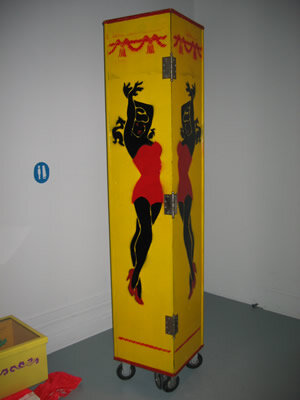GIMMICK
Galerie Sans Nom
Moncton, New Brunswick
March-April 2004
Dunlop Art Gallery
Regina, SK
May 2008
Gimmick
Few of the people I am closest to now know about my sordid past as an aspiring young magician. (Neither do they know that I have trained as a ventriloquist, aspired to be a palm and tealeaf reader and once took the ukulele very seriously.) But that’s beside the point. I have long been fascinated with magic. Real mysticism and unexplainable hocus-pocus, sure, but mostly I mean the sort of magic that wears a top hat which it later pulls a rabbit out of and whose beautiful assistant wears sequins and not much else. There was a time when I hired myself out as a magician for children’s parties and trade show entertainment. And, unlike my previous passions (piano, ventriloquism), I was “good.”
I was a regular customer at Willard’s House of Magic before they tore it down and had earned my way into the club; I was privvy to not only the dimestore selection of plastic tricks, but the ones you might see real magicians performing on TV, the tricks that magicians have, for generations, sworn on their own graves to protect the secrets of.
One of the best-understood reasons why magicians keep their secrets so carefully is that once you see how it works, it’s so damned anticlimactic. And as geeky as hell. Also, no matter what words they prefer to use to describe what they do; illusion, redirection, sleight of hand – it’s lying. (Maybe that’s why I’ve always been so fascinated.)
Gimmicks straddle the line between the image; awe and sparkle of the illusion and the deception of the magician. They are the tools used by magicians to do their job; they create the magic, they are the fulcrum the liar uses to leverage the lie. Without gimmicks, the magic would not exist; the magician would be nothing. They are sparkly, secret compartment-riddled, invisible pockets of magic!
And yet, without the interpreter, the magician, they are nothing. A musical instrument without its’ musician or a tool without its’ carpenter may be pathetic objects, but at least we recognize them and can imagine how they are used. Gimmicks without the magician, without an instruction manual, are completely flaccid, deflated, impotent objects.
They take the joy out of magic without even giving us the satisfaction of figuring out how it was done.
If magic is a “cult”ure, a secret society, then this body of work is an anthropological display of magic artifacts as discovered by a culture with no understanding of that society, completely lacking contextualization. In true magician’s form, however, many of the gimmicks are props of themselves, mockups for gimmicks that never existed, or models for imagined gimmicks that would never work. Oh, we could be so powerful, if only we knew how to use them…





